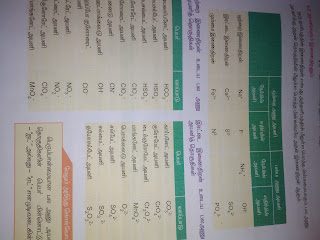ELEMENTS AND COMPOUNDS (Formula, valency)
FORMULA:
A molecule of an element or a compound is represented by means of a formula.
The formula represents the number of atoms of each element in the molecule. For example H2 represents one molecule of hydrogen formed when two atoms of hydrogen combine.
The formula of water is H2O. This indicates that two atoms of hydrogen chemically combined with one atom of Oxygen to form water. The subscript "2" below H indicates the number of atoms of hydrogen present in one molecule of water. Notice that when only one atom is present the subscript "1" is not written.
VALENCY:
Two atoms of hydrogen combine with one atom of Oxygen to form a molecule of water. While one atom of hydrogen combines with one atom of chlorine to form a molecule of hydrogen chloride. You could say that Oxygen atom has a greater capacity to combine with hydrogen than the chlorine atom.
The compounds are formed by combination of atoms of different elements. During the formation of molecules of the compounds, atoms combined in a fixed proportion. This is due to the fact that different atoms have different combining capacities.
Valency can be defined as the combining capacities of an element.
1. Valency with respect to hydrogen:
The valency of hydrogen atom is taken as one and it is selected as the standard. Valency of other elements is expressed in terms of hydrogen. Valency of an element can also be defined as the number of hydrogen atoms which combine with one atom of the element.
Since most of the elements do not combine with hydrogen, the valency or the combining capacities of the element is also defined in terms of chlorine or oxygon.
2. Valency with respect to Chlorine:
Since valency of chlorine is one, the number of chlorine atom with which one atom of an element can combine is called valency.
3. Valency with respect to Oxygen:
We know that the valency of Oxygen is 2. Double the number of atoms with which one atom of an element can combine is also called valency.
Certain elements that exhibit more than one valency, are said to be variable valency elements.
For example,
Valency of Fe in FeCl2 is 2
Valency of Fe in FeCl3 is 3
Some elements, especially rare gases like helium and neon, do not combine with other elements, They have zero valency.
A molecule of an element or a compound is represented by means of a formula.
The formula represents the number of atoms of each element in the molecule. For example H2 represents one molecule of hydrogen formed when two atoms of hydrogen combine.
The formula of water is H2O. This indicates that two atoms of hydrogen chemically combined with one atom of Oxygen to form water. The subscript "2" below H indicates the number of atoms of hydrogen present in one molecule of water. Notice that when only one atom is present the subscript "1" is not written.
VALENCY:
Two atoms of hydrogen combine with one atom of Oxygen to form a molecule of water. While one atom of hydrogen combines with one atom of chlorine to form a molecule of hydrogen chloride. You could say that Oxygen atom has a greater capacity to combine with hydrogen than the chlorine atom.
The compounds are formed by combination of atoms of different elements. During the formation of molecules of the compounds, atoms combined in a fixed proportion. This is due to the fact that different atoms have different combining capacities.
Valency can be defined as the combining capacities of an element.
1. Valency with respect to hydrogen:
The valency of hydrogen atom is taken as one and it is selected as the standard. Valency of other elements is expressed in terms of hydrogen. Valency of an element can also be defined as the number of hydrogen atoms which combine with one atom of the element.
Since most of the elements do not combine with hydrogen, the valency or the combining capacities of the element is also defined in terms of chlorine or oxygon.
2. Valency with respect to Chlorine:
Since valency of chlorine is one, the number of chlorine atom with which one atom of an element can combine is called valency.
3. Valency with respect to Oxygen:
We know that the valency of Oxygen is 2. Double the number of atoms with which one atom of an element can combine is also called valency.
Certain elements that exhibit more than one valency, are said to be variable valency elements.
For example,
Valency of Fe in FeCl2 is 2
Valency of Fe in FeCl3 is 3
Some elements, especially rare gases like helium and neon, do not combine with other elements, They have zero valency.



கருத்துகள்
கருத்துரையிடுக